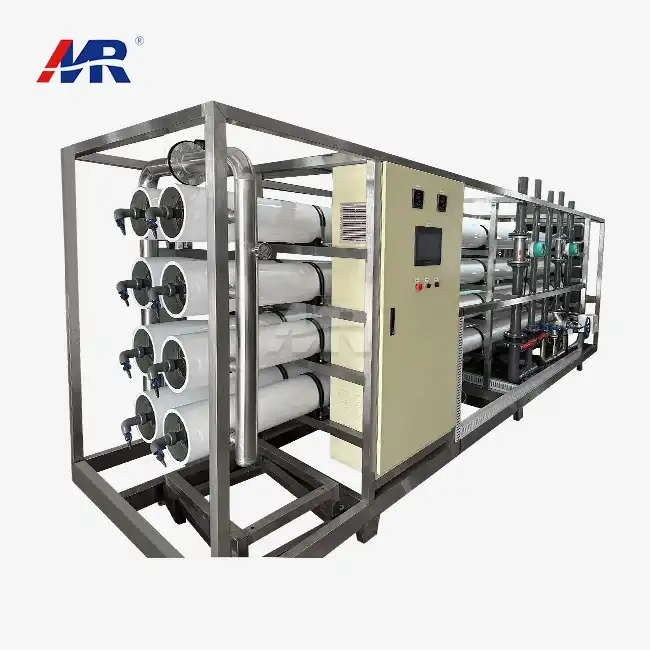Can RO systems treat industrial wastewater for reuse?
Reverse osmosis (RO) systems have emerged as a powerful tool in treating industrial wastewater for reuse. These advanced filtration systems are capable of removing a wide range of contaminants, including dissolved solids, organic compounds, and even some microorganisms, making them highly effective in purifying industrial effluents.
Effectiveness of RO in industrial wastewater treatment
The effectiveness of reverse osmosis systems in treating industrial wastewater lies in their ability to produce high-quality permeate that often meets or exceeds regulatory standards for water reuse. RO membranes can remove up to 99% of dissolved solids, significantly reducing the concentration of pollutants in the treated water. This level of purification makes RO-treated water suitable for various industrial applications, including cooling towers, boiler feed water, and process water in manufacturing facilities.
Industries benefiting from RO wastewater treatment
Several industries have successfully implemented RO systems for wastewater treatment and reuse:
- Petrochemical industry: RO systems help treat and recycle process water, reducing freshwater consumption and minimizing environmental impact.
- Textile manufacturing: RO technology enables the removal of dyes and chemicals from wastewater, allowing for water reuse in production processes.
- Food and beverage production: RO systems purify wastewater to meet stringent quality standards for reuse in cleaning and processing operations.
- Pharmaceutical industry: High-purity water produced by RO systems is essential for manufacturing processes and equipment cleaning.
By implementing RO technology, these industries not only comply with environmental regulations but also achieve significant cost savings through reduced water consumption and wastewater discharge fees.
Challenges of using reverse osmosis plants for sewage treatment
While reverse osmosis plants offer numerous benefits in wastewater treatment, their application in sewage treatment presents several challenges that need to be addressed for optimal performance and cost-effectiveness.
Membrane fouling and scaling
One of the primary challenges in using RO for sewage treatment is membrane fouling and scaling. Sewage contains high levels of organic matter, suspended solids, and dissolved minerals that can quickly accumulate on the membrane surface, reducing its efficiency and lifespan. This issue necessitates frequent cleaning and maintenance, which can increase operational costs and downtime.
High energy consumption
RO systems require significant energy input to maintain the high pressure needed for the osmosis process. When treating sewage, which typically has a higher concentration of contaminants compared to other types of wastewater, the energy demand can be even greater. This high energy consumption can lead to increased operational costs and may pose challenges in areas with limited or expensive energy resources.
Pretreatment requirements
Effective sewage treatment using RO often requires extensive pretreatment to protect the membranes and ensure optimal system performance. This may include processes such as screening, sedimentation, biological treatment, and multimedia filtration. The need for comprehensive pretreatment adds complexity and cost to the overall treatment system.
Brine management
RO systems produce a concentrated waste stream (brine) that contains the removed contaminants. Managing and disposing of this brine can be challenging, especially in inland areas where options for discharge may be limited. Proper brine management is crucial to prevent environmental issues and comply with regulations.
Zero-liquid discharge (ZLD) systems integrating BWRO technology
Zero-liquid discharge (ZLD) systems incorporating brackish water reverse osmosis (BWRO) technology represent a cutting-edge approach to wastewater treatment and water conservation. These advanced systems aim to eliminate liquid waste discharge entirely, maximizing water recovery and minimizing environmental impact.
Integration of BWRO in ZLD systems
In a ZLD system, BWRO plant technology plays a crucial role in the initial stages of water purification. The BWRO process effectively removes dissolved solids and other contaminants from the wastewater, producing a high-quality permeate that can be reused in various applications. The concentrated brine from the BWRO process then undergoes further treatment in subsequent ZLD stages.
Benefits of ZLD systems with BWRO technology
The integration of BWRO technology in ZLD systems offers several advantages:
- Improved water recovery: BWRO systems can achieve high recovery rates, typically ranging from 75% to 85%, significantly reducing the volume of wastewater that needs further treatment in the ZLD process.
- Enhanced water quality: The permeate produced by BWRO meets high purity standards, making it suitable for reuse in various industrial processes or for environmental discharge.
- Reduced energy consumption: By efficiently removing dissolved solids in the initial stages, BWRO technology can help reduce the overall energy requirements of the ZLD system.
- Flexibility in treatment: BWRO systems can be easily scaled and adapted to handle varying wastewater qualities and quantities, providing flexibility in ZLD system design.
Challenges and considerations
While ZLD systems integrating BWRO technology offer significant benefits, there are some challenges to consider:
- High initial capital costs: ZLD systems with advanced technologies like BWRO can have substantial upfront investment requirements.
- Complexity of operation: These systems often require skilled operators and comprehensive maintenance programs to ensure optimal performance.
- Brine concentration: As water is recovered through the BWRO and subsequent ZLD processes, the remaining brine becomes increasingly concentrated, potentially leading to scaling and fouling issues in later stages of treatment.
Despite these challenges, the integration of BWRO technology in ZLD systems represents a promising solution for industries facing strict water discharge regulations or operating in water-scarce regions.
Conclusion
Reverse osmosis equipment has revolutionized wastewater treatment, offering innovative solutions for water purification and reuse across various industries. From treating industrial effluents to tackling the challenges of sewage treatment, RO technology continues to evolve and adapt to meet the growing demands for sustainable water management. The integration of BWRO technology in zero-liquid discharge systems further exemplifies the potential of reverse osmosis in achieving near-complete water recovery and minimizing environmental impact.
As water scarcity and environmental regulations become increasingly pressing concerns, the role of reverse osmosis in wastewater treatment will only grow in importance. By addressing challenges such as membrane fouling, energy efficiency, and brine management, future advancements in RO technology will continue to enhance its effectiveness and applicability in diverse wastewater treatment scenarios.
For businesses and organizations seeking to implement cutting-edge water treatment solutions, partnering with experienced providers of reverse osmosis equipment is crucial. Guangdong Morui Environmental Technology Co., Ltd. stands at the forefront of water treatment innovation, offering state-of-the-art reverse osmosis plants and comprehensive water treatment services. Our expertise spans industrial wastewater treatment, domestic sewage processing, seawater desalination, and drinking water production.
With our advanced 60m³/hour reverse osmosis plants, we provide tailored solutions to meet the unique needs of industries ranging from manufacturing and food production to pharmaceuticals and power generation. Our commitment to excellence is reflected in our one-stop installation and commissioning services, ensuring seamless integration of RO technology into your existing operations.
Take the first step towards sustainable water management and operational efficiency. Contact Guangdong Morui Environmental Technology Co., Ltd. today to explore how our reverse osmosis solutions can transform your wastewater treatment processes. Reach out to us at benson@guangdongmorui.com to discuss your specific requirements and discover the perfect RO system for your needs.
References
1. Johnson, A. R., & Smith, B. T. (2021). Advances in Reverse Osmosis Technology for Industrial Wastewater Treatment. Journal of Water Process Engineering, 42, 102-115.
2. Chen, L., & Wang, Y. (2020). Challenges and Solutions in Reverse Osmosis-Based Sewage Treatment: A Comprehensive Review. Desalination, 488, 114411.
3. Zhang, Q., et al. (2019). Zero-Liquid Discharge Systems Integrating Brackish Water Reverse Osmosis: Performance Analysis and Optimization. Environmental Science & Technology, 53(12), 6824-6833.
4. Greenlee, L. F., et al. (2018). Reverse osmosis desalination: Water sources, technology, and today's challenges. Water Research, 43(9), 2317-2348.
5. Subramani, A., & Jacangelo, J. G. (2017). Emerging desalination technologies for water treatment: A critical review. Water Research, 75, 164-187.
6. Pendergast, M. T. M., & Hoek, E. M. V. (2016). A review of water treatment membrane nanotechnologies. Energy & Environmental Science, 4(6), 1946-1971.

_1745823981883.webp)


